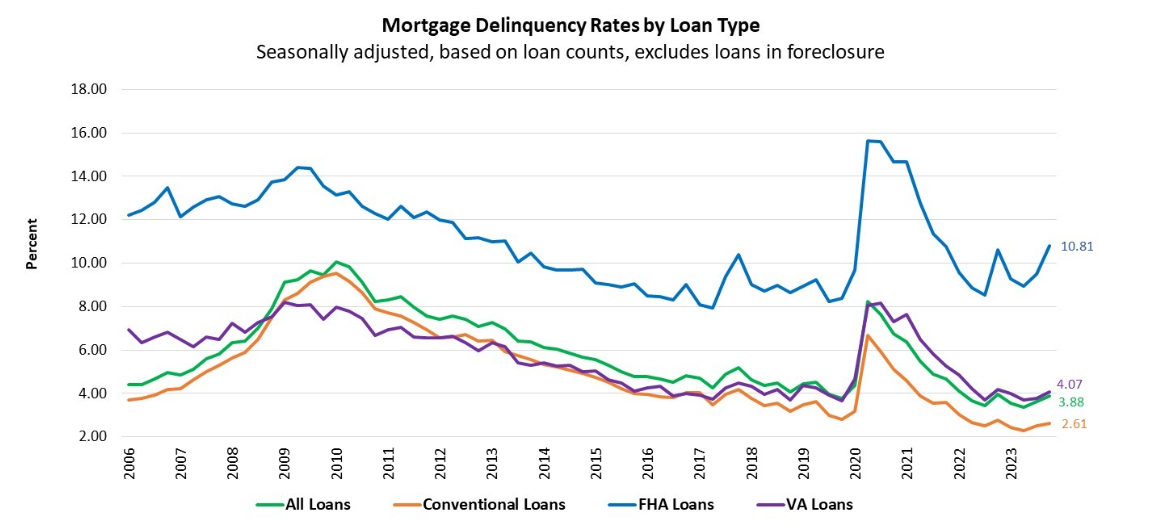The delinquency rate for mortgage loans on one-to-four-unit residential properties increased to a seasonally adjusted rate of 3.88% of all loans outstanding at the end of the fourth quarter of 2023, according to the latest Mortgage Bankers Association’s (MBA) National Delinquency Survey.
The delinquency rate was up 26 basis points from Q3 of 2023, but down eight basis points from one year ago. The historical average for the seasonally adjusted mortgage delinquency rate from 1979 through 2023 is 5.25%. Of particular note, FHA delinquencies were up 131 basis points. The percentage of loans on which foreclosure actions were started in Q4 remained unchanged at 0.14%.
“Mortgage delinquencies increased across all product types for the second consecutive quarter,” said Marina Walsh, CMB, MBA’s VP of Industry Analysis. “While the overall delinquency rate is still very low compared to the historical average, the pace of new loans entering delinquency picked up and some loans moved into later stages of delinquency. The resumption of student loan payments, robust personal spending, and rising balances on credit cards and other forms of consumer debt, paired with declining savings rates, are likely behind some borrowers falling behind at the end of 2023.”

Key findings of the MBA’s Q4 National Delinquency Survey:
- Compared to last quarter, the seasonally adjusted mortgage delinquency rate increased for all loans outstanding. By stage, the 30-day delinquency rate increased seven basis points to 2.10%, the 60-day delinquency rate increased 11 basis points to 0.73%, and the 90-day delinquency bucket increased seven basis points to 1.05%.
- By loan type, the total delinquency rate for conventional loans increased 11 basis points to 2.61% over the previous quarter. The FHA delinquency rate increased 131 basis points to 10.81%, the highest level since Q3 of 2021. The VA delinquency rate increased by 31 basis points to 4.07%.
- On a year-over-year basis, total mortgage delinquencies decreased for all loans outstanding. The delinquency rate decreased by 17 basis points for conventional loans, increased 20 basis points for FHA loans and decreased nine basis points for VA loans from the previous year.
- The delinquency rate includes loans that are at least one payment past due but does not include loans in the process of foreclosure. The percentage of loans in the foreclosure process at the end of the fourth quarter was 0.47%, down two basis points from Q3 of 2023, and 10 basis points lower than one year ago. This is the lowest foreclosure inventory rate since Q4 of 2021.
- The non-seasonally adjusted seriously delinquent rate, the percentage of loans that are 90 days or more past due or in the process of foreclosure, was 1.52%, matching the lowest level since 1984. It remained unchanged from last quarter and decreased by 37 basis points from last year. Compared to a year ago, the seriously delinquent rate decreased by 26 basis points for conventional loans, decreased 98 basis points for FHA loans and decreased 42 basis points for VA loans.
- The five states with the largest quarterly increases in their overall delinquency rate were: Louisiana (77 basis points), West Virginia (53 basis points), Illinois (44 basis points), Texas (44 basis points), and New Mexico (42 basis points).
“The labor market is still quite resilient with the unemployment rate–strongly correlated with mortgage performance–remaining at 3.7% in January,” added Walsh. “Any weakening in employment conditions would likely lead to more borrowers falling behind on their payments in the coming quarters.”
Earlier this week, the Bureau of Labor Statistics (BLS) reported that unemployment rates were higher in December than a year earlier in 230 of the 389 metropolitan areas, lower in 128 areas, and unchanged in 31 areas. A total of nine areas had jobless rates of less than 2% and 10 areas had rates of at least 8%. Nonfarm payroll employment increased over the year in 61 metropolitan areas and was essentially unchanged in 328 areas. The national unemployment rate in December was 3.5%, not seasonally adjusted, up slightly from 3.3% a year earlier.







